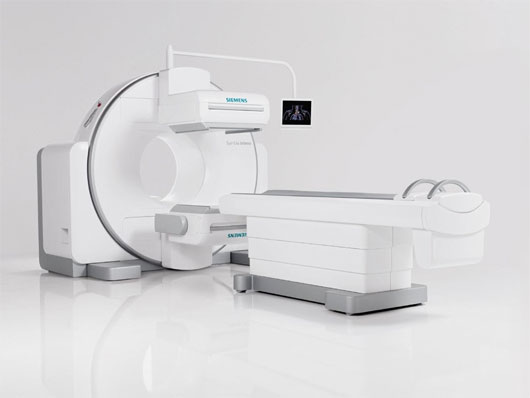Siemens introduces a breakthrough in the field of tomography
At the 99th North American X-ray (RSNA) exhibition in Chicago (USA), Siemens introduced Symbia Intevo, the first system in the world to fully integrate computerized tomography capabilities. SPECT radiation (SPECT) with computerized tomography (CT ), thereby relying on high resolution of CT to allow more accurate diagnosis of injury and help with the initial therapeutic activities following there.
Symbia Intevo is the world's first xSPECT system , a complete integration of both SPECT and CT data systems. The level of detail from this combination has helped to differentiate the conditions more accurately, such as distinguishing between malignant disease and osteoarthritis. The first time Symbia Intevo provided enough images to help better monitor disease, as well as provide a more reliable assessment of disease treatment.
So far, SPECT / CT composite images are still based on rebuilding / combining activities from SPECT and CT images separately. Such SPECT / CT images will obviously be blurred by the causes: High resolution CT images will have to reduce resolution to as low as SPECT images.
Although this method helps determine the basic location of anatomical disease, the mismatch of SPECT and CT images limits the doctor's ability to diagnose and monitor the disease.

Symbia Intevo, the first system in the world to fully integrate computerized tomography with SPECT (SPECT) with computerized tomography (CT).(Source: healthcare.siemens.com)
Historically, doctors had to use CT images to determine disease location and SPECT images to determine its metabolic activity. They will have to adjust the disease position in the SPECT images with information obtained from the CT image.
Siemens Symevo Intevo xSPECT system will minimize this "tuning" operation, thanks to the new technology using CT as the reference frame instead of SPECT, thereby combining SPECT and CT data completely.
This method is built on new hardware and a repetitive reconstruction algorithm, which is responsible for controlling detector movement, signal deviation processing, size and shape of collimated pipe holes. and distance from patient to detectors.
Raw data obtained from SPECT and CT receivers will be processed by a leading modern 64-bit computer, allowing the reconstruction of high-resolution images.
The xSPECT method implements modern algorithms that help to position each 3D pixel into one of five categories: gas, fat, soft tissue, spongy bone and solid bone. The clear classification has provided the basic foundation to improve bone image resolution, which is a major challenge for conventional SPECT / CT image combinations.
XSPECT images show a clear description of the areas of bone, soft tissue and lesions present there. This helps the therapist make a clear distinction between cancer-induced lesions and degenerative lesions.
Correct matching of SPECT and CT data in the xSPECT system also helps to better track and calculate the metabolic rate of a tumor. With Quant in xSPECT, doctors can rely on the information obtained to evaluate the effectiveness of treatment for patients.
Although Symbia Intevo uses more CT data than before, Siemens can still limit making patients exposed to radiation through bringing combined applications to reduce radiation exposure (CARE). These applications are only available in Siemens, including CARE Dose4D, which can reduce the patient's exposure to CT radiation by up to 68%.
- Dual source tomography machine - A breakthrough of CT technology
- Reduce 80% of treatment time for cancer patients
- Who invented the layered computer tomography?
- Nokia, Siemens postpone the consolidation plan
- Russian scientists created a scanner that could detect even the smallest crack in an airplane
- Siemens Group Germany announced it would give up nuclear power
- Siemens spent 3.5 billion USD to buy UGS
- Super computer scanners
- Nokia Siemens successfully tested 4G networks
- Software supports tomography to detect lung cancer
- Siemens launched Gamma room temperature control
- China developed the world's most sensitive submarine detector?
 Green tea cleans teeth better than mouthwash?
Green tea cleans teeth better than mouthwash? Death kiss: This is why you should not let anyone kiss your baby's lips
Death kiss: This is why you should not let anyone kiss your baby's lips What is salmonellosis?
What is salmonellosis? Caution should be exercised when using aloe vera through eating and drinking
Caution should be exercised when using aloe vera through eating and drinking